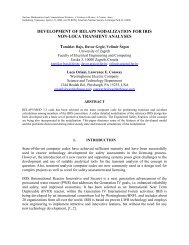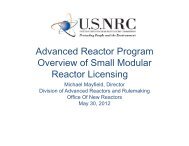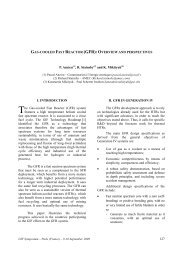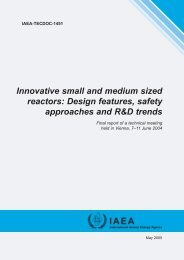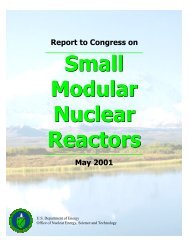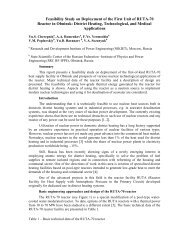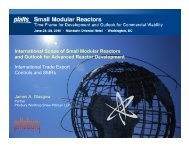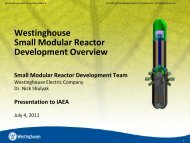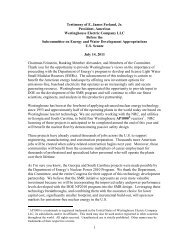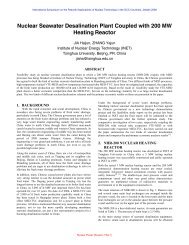Reactor Technology Development under the HTTR Project.pdf - UxC
Reactor Technology Development under the HTTR Project.pdf - UxC
Reactor Technology Development under the HTTR Project.pdf - UxC
You also want an ePaper? Increase the reach of your titles
YUMPU automatically turns print PDFs into web optimized ePapers that Google loves.
REACTOR TECHNOLOGY DEVELOPMENT<br />
UNDER THE <strong>HTTR</strong> PROJECT<br />
Takakazu TAKIZUKA<br />
Japan Atomic Energy Research Institute<br />
The 1st COE-INES International Symposium, INES-1<br />
October 31 – November 4, 2004<br />
Keio Plaza Hotel, Tokyo, Japan
<strong>HTTR</strong> <strong>Project</strong><br />
<strong>Reactor</strong> <strong>Technology</strong><br />
<strong>HTTR</strong> Operation and Testing<br />
Achievement of 950°C (April 2004)<br />
Safety Demonstration Tests<br />
GTHTR Plant Design and Gas Turbine <strong>Technology</strong> R&D<br />
Design of GTHTR300 (electricity, 850°C) and<br />
GTHTR300C (cogeneration, 950°C)<br />
Tests of Control, Magnetic Bearing, and System Control<br />
Hydrogen Production <strong>Technology</strong><br />
System Integration<br />
Simulation Tests, Isolation Valve Test<br />
IS Process<br />
Bench-scale Tests<br />
Pilot-scale Test (from 2005)<br />
<strong>HTTR</strong>-IS (from 2010)
<strong>HTTR</strong><br />
High Temperature Engineering Test <strong>Reactor</strong><br />
Graphite-moderated, helium gas-cooled reactor<br />
Thermal power: 30 MW<br />
Coolant outlet temperature:<br />
850°C in <strong>the</strong> rated operation<br />
950°C in <strong>the</strong> high-temperature test operation<br />
The first high-temperature gas-cooled reactor in Japan<br />
Designed, constructed, and operated by JAERI<br />
Located at <strong>the</strong> JAERI Oarai site<br />
Purposes:<br />
to establish HTR technology<br />
to demonstrate HTR safety operation and inherent safety characteristics<br />
to demonstrate nuclear heat utilization<br />
to irradiate HTR fuels and materials
Major Technical R&D Facilities<br />
VHTRC (Very High Temperature<br />
<strong>Reactor</strong> Critical Assembly)<br />
<strong>Reactor</strong> Physics 1985-1995<br />
HENDEL (Helium Engineering<br />
Demonstration Loop)<br />
Thermal Hydraulics, etc. 1982-1995<br />
OGL-1 (Oarai Gas Loop-1)<br />
1000°C helium loop in JMTR<br />
Fuel Irradiation 1985-1995<br />
Material Test Machine<br />
High temperature fatigue test machine<br />
for super alloy in helium gas. 1981-
<strong>HTTR</strong> Milestones<br />
1991/03 Construction started<br />
1996/10 Functional test started<br />
1998/11 First criticality<br />
1999/09 Power-up test started<br />
2001/12 Full-power operation (single loaded) at 850°C<br />
2002/02 Full-power operation (parallel loaded) at 850°C<br />
2003/03 Safety demonstration test started<br />
2004/04 High temperature operation (single loaded) at 950°C<br />
2004/06 High temperature operation (parallel loaded) at 950°C
Cutaway View of RPV and Core of <strong>HTTR</strong><br />
RPV height/diameter: 13.2/5.5 m<br />
Core height/diameter: 2.9/2.3 m<br />
Fuel columns: 30, Control columns: 7<br />
Fuel Element: pin-in-block type<br />
height/across flats: 580/360 mm<br />
Fuel: TRISO coated UO 2 (6% enrichment)<br />
Control rods: 16 pairs
Major Specifications of <strong>HTTR</strong><br />
Thermal Power<br />
Outlet Coolant Temperature<br />
Inlet Coolant Temperature<br />
Fuel<br />
Fuel Element Type<br />
Fuel Loading<br />
Core Diameter<br />
Core Height<br />
Average Core Power Density<br />
Flow Direction<br />
Number of Main Loop<br />
Coolant Flow Rate<br />
Effective Core Coolant Flow<br />
Primary Coolant Pressure<br />
30 MW<br />
850/950°C<br />
395°C<br />
Low Enriched UO 2<br />
(6wt%)<br />
Prismatic Block<br />
Off-load, 1 Batch<br />
2.3 m<br />
2.9 m<br />
2.5 W/m 3<br />
Downward Flow<br />
1<br />
10.2 kg/s (950°C Operation)<br />
88%<br />
4.0 MPa
Cooling System of <strong>HTTR</strong><br />
Loop operation modes:<br />
Single loaded operation<br />
<strong>Reactor</strong> PPWC<br />
30 MW<br />
Parallel loaded operation<br />
PPWC<br />
<strong>Reactor</strong> 20 MW<br />
IHX<br />
10 MW<br />
SPWC
High-temperature Test Operation at 950 o C<br />
Performance tests at 950 o C were completed, and<br />
JAERI received an operation permit for <strong>the</strong> high-temperature test operation<br />
(950 o C operation) of <strong>the</strong> <strong>HTTR</strong> from <strong>the</strong> government.<br />
<strong>Reactor</strong> Power (MW)<br />
50<br />
45<br />
40<br />
35<br />
30<br />
25<br />
20<br />
15<br />
10<br />
5<br />
0<br />
<strong>Reactor</strong> Outlet Coolant<br />
Temperature<br />
<strong>Reactor</strong> Power<br />
31-May 5-Jun 10-Jun 15-Jun 20-Jun 25-Jun 30-Jun<br />
Date (2004)<br />
1000<br />
900<br />
800<br />
700<br />
600<br />
500<br />
400<br />
300<br />
200<br />
100<br />
0<br />
Temperature (°C)
Safety Demonstration Test<br />
to demonstrate characteristics of HTRs<br />
to obtain transient data for code validation<br />
to establish safety design and evaluation technology of HTRs<br />
Reactivity Insertion Test<br />
Increase of reactivity due to withdrawal of <strong>the</strong> central pair of control rods<br />
Coolant Flow Reduction Test<br />
Reduction of primary coolant flow due to trip of primary helium gas circulators
Fission Product Confinement<br />
Failure fraction of <strong>the</strong> first-loading fuel of <strong>the</strong> <strong>HTTR</strong><br />
Through-coatings failure fraction: 2 x 10 -6 (Design criteria:1.5 x 10 -4 )<br />
SiC-failure fraction: 8 x 10 -5 (Design criteria:1.5 x 10 -3 )
Gas Turbine High Temperature <strong>Reactor</strong>, GTHTR300<br />
GTHTR300 <strong>Project</strong> (2001-2007)<br />
Thermal power: 600 MW<br />
Electric power: ~280 MW<br />
Coolant outlet temperature: 850°C<br />
Design of GTHTR300 plant<br />
(<strong>Reactor</strong>, Power conversion system, Safety, Maintenance, Cost)<br />
R&D on helium gas-turbine system<br />
(Compressor, Magnetic Bearing, Operation & Control, Recuperator)<br />
Purposes:<br />
to establish feasible design of commercial power plant<br />
to establish power conversion system technology<br />
prototype plant in 2010's, commercial plant in 2020's<br />
technology base for developing Advanced GTHTR and Cogeneration HTR
GTHTR300 Design Features<br />
Modular plant<br />
Fully inherent and passive reactor safety<br />
Improved pin-in-block type fuel element<br />
High burnup and long refueling interval<br />
Conventional steel reactor pressure vessel<br />
Non-intercooled Brayton cycle<br />
Horizontal single shaft turbo-machine<br />
Magnetic bearings to support turbo-machine rotor<br />
Separate containment of turbo-machine and heat exchangers
GTHTR300 Plant Layout
GTHTR300 <strong>Reactor</strong> Design<br />
Thermal power 600 MWt Fuel temperature 1379°C (max.)<br />
Core shape Annular Fuel element Pin-in-block prism<br />
Power density 5.4 MW/m 3 Enrichment 14%<br />
Coolant temperature inlet: 587°C Burnup 120 GWd/t<br />
outlet: 850°C Cycle length 730 days ( 2 batch)<br />
Core effective flow 82% Pressure vessel SA533 (Mn-Mo) steel<br />
Core pressure drop 58 kPa<br />
Horizontal cross section of reactor core
GTHTR300 Fuel Design<br />
Design Criteria<br />
Maximum fuel temperature 1400°C (normal)<br />
Average burnup<br />
1600°C (accident)<br />
120 GWd/t<br />
Coated Fuel Particle Dimension<br />
Fuel Element<br />
Fuel Compact<br />
UO 2 kernel diameter 0.55 mm<br />
Coating layer thickness<br />
Buffer layer 0.14 mm<br />
Inner PyC layer 0.025 mm<br />
SiC layer 0.045 mm<br />
Outer PyC layer 0.025 mm<br />
Coated fuel particle diameter 1.01 mm
Power Conversion System Design<br />
Helium gas working fluid, Closed-cycle<br />
Direct cycle (no IHX)<br />
Non-intercooled, regenerative Brayton cycle<br />
Heat Exchanger Vessel<br />
<strong>Reactor</strong> Vessel<br />
600 MWt, 850°C, 3.5-7 MPa<br />
Separation of PCV/HXV<br />
Horizontal, single-shaft GT<br />
Recuperator<br />
Plate-fin type, compact HX<br />
Non-cooled 3D turbine blade<br />
3D compressor blade<br />
Turbine Compressor Generator<br />
Precooler<br />
Helical-coil type, low-fin tube HX<br />
Waste heat dumped to sea<br />
Power Conversion Vessel<br />
Submerged generator<br />
Magnetic bearings<br />
Flexible coupling at GT/generator
Turbo-machine design<br />
Turbine: 6 stage, 850°C inlet temperature, 1.87 pressure ratio, 92.8% efficiency<br />
Compressor: 20 stage, 28°C inlet temperature, 2.0 pressure ratio, 90.5% efficiency<br />
Generator: 3-phase AC synchronous generator, helium-cooled<br />
Electric power: 275 MW, Power conversion efficiency: 45.8%
Cost Estimation<br />
Construction Cost per Unit (n-th plant, 4 unit/plant)<br />
<strong>Reactor</strong><br />
¥17,080M<br />
Power Conversion<br />
¥14,011M<br />
Auxiliary ¥ 6,723M<br />
Electric, Instrumentation & Control ¥ 5,780M<br />
Buildings<br />
¥11,071M<br />
Total<br />
¥54,665M (¥0.199M/kW)<br />
Electricity Cost (3% discount rate, 40 years operation)<br />
80% availability 90% availability<br />
Capital *1 ¥1.57/kWh ¥1.47/kWh<br />
Operation & Maintenance ¥1.11/kWh ¥0.99/kWh<br />
Fuel *2 ¥1.46/kWh ¥1.46/kWh<br />
Total ¥4.14/kWh ¥3.84/kWh<br />
*1: including decommissioning cost, *2: including reprocessing cost<br />
Electricity cost from LWR: ¥5.3/kWh (FEPC 2001)
Ongoing R&D on Power Conversion System<br />
Scaled model tests to demonstrate key technologies for <strong>the</strong> GTHTR power<br />
conversion system<br />
Compressor Aerodynamic Performance Test (2003-2004)<br />
to verify aerodynamic performance and design method<br />
Magnetic Bearing <strong>Development</strong> Test (2005-2007)<br />
to develop technology of magnetic bearing supported rotor system<br />
to verify rotor design<br />
Gas-Turbine System Operation and Control Test (2007-2010)<br />
to demonstrate operability and controllability of closed-cycle gas-turbine system
Compressor Aerodynamic Performance Test<br />
Features of helium gas compressor<br />
high boss ratio, large number of stages, nearly parallel flow passage<br />
high Reynolds number, low Mach number<br />
Compressor model<br />
1/3-scale, 4-stage, 10800 rpm<br />
Helium gas loop<br />
~1 MPa
Air Gas Turbine vs. Helium Gas Turbine<br />
Open-Cycle Industrial Gas Turbine (π = 20, θ TI = 1450°C)<br />
Mitsubishi M701G 334 MWe, 39.5%<br />
Industrial Gas Turbine<br />
Compressor<br />
17 stages<br />
Turbine<br />
6 stages<br />
Turbine<br />
4 stages<br />
Compressor<br />
20 stages<br />
Compressor<br />
Stator Bade<br />
Compressor<br />
Rotor Bade<br />
Closed-Cycle Helium Gas Turbine (π = 2, θ TI = 850°C)<br />
GTHTR300 275 MWe, 45.8%<br />
GTHTR300
Compressor Model and Helium Gas Loop
Major Design Parameters of Compressor Model<br />
Flow rate<br />
12.2 kg/s<br />
Inlet temperature 30°C<br />
Inlet pressure<br />
0.883MPa<br />
Pressure ratio 1.156<br />
Base diameter<br />
500 mm<br />
Tip diameter (1st stage)<br />
568 mm<br />
Boss ratio (1st stage) 0.88<br />
Number of stages 4<br />
Rotational speed<br />
10800 rpm<br />
Peripheral speed of rotor blade<br />
321 m/s<br />
Number of rotor/stator blades (1st stage) 72/94<br />
Rotor/stator blade chord length (1st stage) 28.6/35 mm<br />
Rotor/stator blade height (1st stage) 34/33.7 mm
Aerodynamic Performance Results<br />
The first series of aerodynamic performance tests was completed in March 2003.<br />
Performance results showed good agreement with <strong>the</strong> prediction.<br />
Extrapolation to <strong>the</strong> full scale compressor condition estimated an efficiency over 90%.<br />
Pressure ratio at <strong>the</strong> rated rotational speed<br />
Blade section efficiency at <strong>the</strong> rated rotational speed
Turbo-machine Rotor System<br />
Single shaft, Two span (Turbo-compressor rotor and Generator rotor),<br />
Flexible coupling connection, Magnetic bearing support<br />
Rotational speed: 3600 rpm, Length: 12 + 13 m, Mass 46,100 + 66,500 kg<br />
Magnetic bearings need no liquid lubricants, completely eliminating <strong>the</strong><br />
possibility of lubricant ingress into <strong>the</strong> primary system.<br />
Turbo-compressor rotor<br />
Generator rotor<br />
MB (radial)<br />
MB (radial + axial)<br />
MB (radial + axial)<br />
MB (radial)<br />
from<br />
<strong>Reactor</strong> core<br />
Turbine Compressor Flexible Coupling Generator<br />
to Recuperator<br />
Power conversion vessel
Rotor Dynamics<br />
Magnetic bearings have lower load capacity and lower stiffness than oil bearings.<br />
The stiffness of <strong>the</strong> magnetic bearings is around 10 9 N/m.<br />
The rotors operate above bending mode critical speeds<br />
Critical speed map for <strong>the</strong><br />
turbo-compressor rotor<br />
Critical speed map for <strong>the</strong><br />
generator rotor
Turbo-machine Rotor Model Test<br />
Testing of magnetic bearing performance, unbalance response, stability<br />
and auxiliary bearing reliability.<br />
<strong>Development</strong> of advanced control method<br />
Rotor model<br />
1/3-scale (1/10 in mass), Variable speed (rated 3600 rpm)
Gas-turbine System Operation and Control Test<br />
Test objectives;<br />
to establish an operation and control method of closedcycle<br />
gas-turbine systems,<br />
to accumulate system transient data, and<br />
to develop and verify a plant dynamics analysis code.<br />
Operation modes;<br />
full power steady-state normal operation,<br />
partial power steady-state normal operation,<br />
start-up,<br />
shutdown<br />
load change,<br />
loss of load, and<br />
emergency shutdown
Schematic Flow Diagram of <strong>the</strong> Test Facility<br />
Integrated scaled model of GTHTR300 power conversion system<br />
650°C<br />
638°C<br />
1.00 MPa<br />
Generator<br />
Heater<br />
1.32 MW<br />
500°C<br />
30°C<br />
0.79 MPa<br />
Control valves<br />
Compressor<br />
0.37 MW<br />
69°C<br />
1.02 MPa<br />
Turbine<br />
0.53 MW<br />
576°C<br />
0.80 MPa<br />
Precooler<br />
Recuperator<br />
Flow diagram of <strong>the</strong> test facility (reference design)<br />
Working fluid: Helium<br />
Flow rate: 1.7 kg/s
Turbine Model<br />
1/7-scale, 2-stage axial turbine (reference design)<br />
Flow rate<br />
1.66 kg/s<br />
Inlet pressure<br />
1.00 MPa<br />
Inlet temperature 641°C<br />
Pressure ratio 1.24<br />
Rotational speed 23400 rpm<br />
Number of stages 2<br />
Inlet outer diameter 336 mm<br />
Inlet hub diameter 281 mm<br />
Blade height<br />
27.5 mm
Very High Temperature <strong>Reactor</strong> (VHTR)<br />
Very high temperature reactor with 950°C reactor outlet temperature enables;<br />
Electricity generation at a higher efficiency around 50%,<br />
Hydrogen production by <strong>the</strong>rmo-chemical processes, and<br />
Cogeneration of electricity and hydrogen.<br />
<strong>HTTR</strong> and GTHTR300 offer technology base for VHTR<br />
Preliminary design of <strong>the</strong> 950°C reactor core<br />
Thermodynamic cycle of <strong>the</strong> 950°C power conversion system<br />
VHTR plant for cogeneration (GTHTR300C)
950°C <strong>Reactor</strong> Preliminary Design<br />
950°C core design with little modifications<br />
Power distribution flattened<br />
Fuel element design unchanged<br />
Core internals design unchanged<br />
950°C core 850°C core<br />
Thermal Power 600 MW 600 MW<br />
Power density 5.4 MW/m 3 5.4 MW/m 3<br />
Core outlet temperature 950°C 850°C<br />
Core inlet temperature 587°C 587°C<br />
Fuel temperature (max.) 1377°C 1379°C<br />
Burnup (average) 118 GWd/t 120 GWd/t<br />
Cycle length 550 days (2 batch) 730 days (2 batch)<br />
Refueling bach 2 2<br />
CFP packing fraction 21.8% 29.0%<br />
Enrichment 5 (11.0-16.4%) 1 (14%)<br />
BP diameter 1 2<br />
BP concentration 2 7
Gas Turbine Cycle for 950°C<br />
With 950°C core, 50% Power conversion efficiency is attainable<br />
without any significant design change to GTHTR300 power<br />
conversion system.<br />
950°C PCS 850°C PCS<br />
Core outlet temperature 950°C 850°C<br />
Core inlet temperature 663°C 587°C<br />
Pressure ratio 2.0 2.0<br />
Turbine efficiency 94% 93%<br />
Compressor efficiency 91.5% 90.5%<br />
Recuperator effectiveness 95% 96%<br />
Turbine cooling flow 1.5% 1%<br />
Power conversion efficiency 50% 45.8%
Cogeneration Plant GTHTR300C<br />
Least design changes from that of GTHTR300 plant<br />
Minimum additional R&D<br />
Topping with hydrogen production process on gas-turbine cycle
Design Features of GTHTR300C<br />
Based on <strong>the</strong> GTHTR300 plant design<br />
950°C core outlet coolant temperature<br />
950-850°C for hydrogen production<br />
850°C< for electricity generation<br />
5 MPa coolant pressure<br />
Helical tube-and-shell type IHX<br />
Turbo-compressor design unchanged<br />
Recuperator and precooler design unchanged
Comparison of Cogeneration Plant with Power Plant<br />
GTHTR300C<br />
GTHTR300<br />
cogeneration plant power plant<br />
<strong>Reactor</strong> <strong>the</strong>rmal power [MWt] 600 600<br />
Core power density [W/cc] 5.4 5.4<br />
Core outlet temperature [°C] 950 850<br />
Core inlet temperature [°C] 594 587<br />
Core coolant pressure [MPa] 5.1 6.9<br />
Core coolant flow rate [kg/s] 324 439<br />
GT cycle pressure ratio [-] 2.0 2.0<br />
Power conversion efficiency [%] 46.7 45.8<br />
Electricity production [MWe] 202 275
Intermediate Heat Exchanger (IHX)<br />
Helical tube-and-shell type He/He IHX is operating at 950°C C in <strong>HTTR</strong><br />
Hastelloy-XR (helium ~1000°C)<br />
High temperature structural design guideline<br />
Licensing and Operating experiences<br />
IHX design for <strong>the</strong> GTHTR300C follows that of <strong>the</strong> <strong>HTTR</strong><br />
Type: Helical tube-and shell<br />
Material: Hastelloy-XR<br />
Tube sizing: 31.75 mm OD × 24.75 mm ID
Comparison of GTHTR300C IHX with <strong>HTTR</strong> IHX<br />
GTHTR300C<br />
<strong>HTTR</strong><br />
Thermal rating [MWt] 170 10<br />
Primary side<br />
Inlet/outlet temperature [°C] 950/850 950/389<br />
Pressure [MPa] 5.02 4.06<br />
Flow rate [kg/s] 323.8 3.4<br />
Secondary side<br />
Inlet/outlet temperature [°C] 500/900 237/869<br />
Pressure [MPa] 5.15 4.21<br />
Flow rate [kg/s] 81.0 3.0<br />
LMTD [°C] 154 113<br />
Heat transfer area [m 2 ] 972 244<br />
Effective tube bundle OD/length [m] 5.20/2.60 1.30/4.87
Conceptual Layout of GTHTR300C
Concluding Remarks<br />
JAERI is carrying out <strong>the</strong> HTR technology development <strong>under</strong> <strong>the</strong> <strong>HTTR</strong> project.<br />
The <strong>HTTR</strong> successfully achieved full power at <strong>the</strong> outlet coolant temperature of<br />
950°C.<br />
Design of <strong>the</strong> GTHTR300 power plant and R&D on a gas-turbine system are<br />
<strong>under</strong>way with a goal of near-term commercial deployment.<br />
The GTHTR300 design will demonstrate competitive economy and high degree of<br />
safety. The R&D on helium gas turbines will establish technology of high-efficiency<br />
power conversion.<br />
A concept of a cogeneration plant GTHTR300C is proposed to meet <strong>the</strong> future<br />
demand for hydrogen and electricity.



